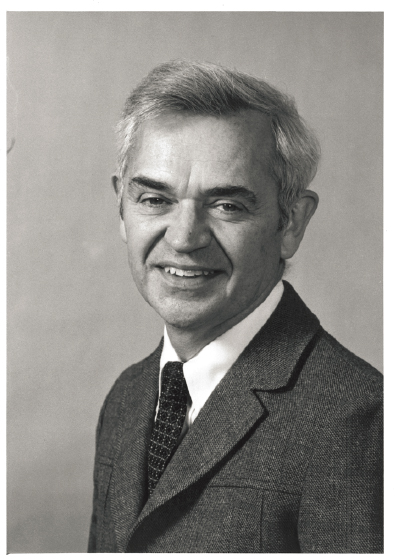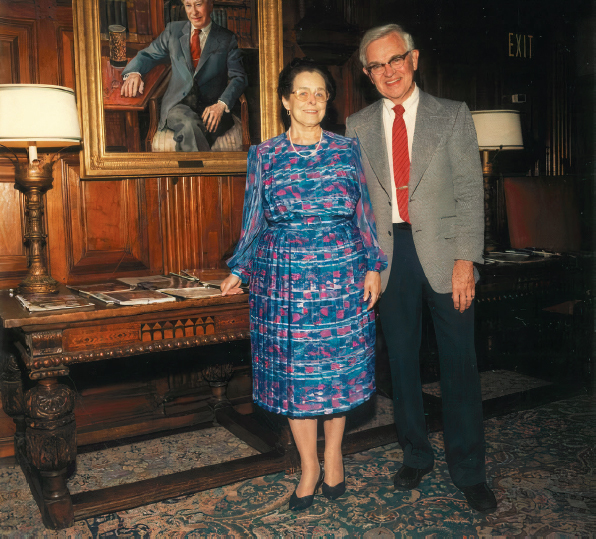

FRANK E. MARBLE
1918–2014
Elected in 1974
“Contributions in aero-thermo-chemistry, and applications to problems of gas turbines.”
BY ANN R. KARAGOZIAN
FRANK EARL MARBLE, among the nation’s preeminent aerospace propulsion scientists during the second half of the 20th century, passed away August 11, 2014, at the age of 96. His pioneering technical contributions changed the direction of several important fields that are foundational to both aircraft and rocket systems. He also made outstanding contributions to aerospace engineering through his gifted teaching and insightful training of legions of graduate students at the California Institute of Technology and through his example of courage and loyalty during the McCarthy era and long afterward.
Frank was born July 21, 1918, in Cleveland, Ohio, and from a young age developed a passion for two things that remained with him throughout his life: airplanes and music. Ohio in the 1920s and 1930s was becoming a rather significant player in the development of America’s burgeoning aviation industry. Young Frank took the streetcar regularly to the Cleveland Hopkins Airport, where he would wander into the hangars, look at the airplanes up close, and talk with the pilots and mechanics. This set him on a lifelong journey of discovery with aircraft.
___________________
This tribute is adapted from Proceedings of the US National Academy of Sciences 112(18):5550–51 (available at https://doi.org/10.1073/pnas.1501896112).
His love of music also began at an early age, when he took up the trombone. He showed a great deal of talent, and twice won the state championship in trombone solo.
Frank’s fascination with airplanes eventually won out over his musical focus, at least professionally. With financial assistance from his aunt and sister, he entered the Case School of Applied Science (now Case Western Reserve University) and majored in mechanical engineering. While there his eyes were opened to the exciting world of aeronautics, the newly established field underlying the mechanics of flight.
As he developed his technical gifts and interests, he dreamed of pursuing graduate studies at Caltech with the eminent fluid mechanician Theodore von Kármán, but the outbreak of World War II altered his plans temporarily. After completing his master’s degree in applied mechanics at Case (1942), he worked at the newly established aeropropulsion laboratory in Cleveland, created by the National Advisory Council on Aeronautics (NACA); this was the predecessor of NASA’s Glenn Research Center at Lewis Field.
As “employee number 67” of the NACA Engine Research Lab, Frank was responsible for tackling a number of technological problems related to aircraft engines used in the war effort. He was able to solve engine cooling problems on the B-26 bomber (the Martin Marauder) and B-29 bomber (Superfortress). While the propulsion systems for these bombers were of the air-cooled reciprocating/radial type, Frank’s work at NACA also introduced him to gas turbine engine technologies, which showed promise for future air transportation systems. He credited the experience with changing the direction of his focus and career from aerodynamics to jet propulsion.
After the war, Frank received a National Research Council predoctoral fellowship to study at Caltech, and he and his young wife, Ora Lee (née Collins), headed to California in their “house trailer.” What started as a short stay for his doctorate turned into a lifelong association with Caltech and Pasadena, where Frank and Ora Lee raised their children, Steve and Patricia.
Frank thoroughly enjoyed and excelled in his graduate classes in advanced mathematics, physics, and aeronautics. And although his formal doctoral coadvisors in Caltech’s Guggenheim Aeronautical Laboratory were von Kármán and the rising young fluid mechanician Hans Liepmann, his thesis topic was one that he had brought with him from his work at NACA, involving the fundamental fluid physics of rotating blades.1
His pioneering doctoral work, among the first to use rigorous mathematical methods to analyze blade aerodynamics in turbomachinery, led to his hiring at Caltech immediately after his graduation in 1948. He started as an instructor in aeronautics, and then became an assistant professor of jet propulsion and mechanical engineering. It was during this time that he encountered yet another unexpected career diversion: his appointment by Prof. Tsien Hsue-shen as part-time chief of combustion research at Caltech’s new off-campus facility, the Jet Propulsion Laboratory. The position was concurrent with his faculty appointment at Caltech.
Like his unexpected involvement in gas turbine engines at NACA, Frank’s work at JPL opened up several new research directions for him based on important aerospace propulsion problems of that era. His work on exploring ramjet engines led to a seminal analytical approach for predicting premixed flame stability in shear layers, developed with one of his earliest doctoral students, Tom Adamson.2 Known as the Marble-Adamson problem, its use of activation energy asymptotics became a model for scores of researchers exploring both premixed and nonpremixed flame stabilization.
Frank’s work at JPL and Caltech also involved experiments and analysis of the often catastrophic “screech” phenomenon
___________________
1 Marble FE. 1948. Some problems concerning the rotational motion of a perfect fluid. PhD dissertation, California Institute of Technology. Available at thesis.library.caltech.edu/4518/.
2 Marble FE, Adamson TC Jr. 1954. Ignition and combustion in a laminar mixing zone. Journal of Jet Propulsion 24(2):85–94.
in ramjets and afterburners3; this led him and his collaborators to develop one of the first phenomenological explanations of acoustically coupled combustion instabilities and bluff-body flame-holding mechanisms.4
After he became a full professor in 1957, Frank stepped down from his JPL post. But he continued throughout his career to work as a consultant for numerous government and industrial organizations, pursuing problems relevant to both air-breathing and rocket propulsion systems. These experiences, in addition to his funded research from the US government, led to the exploration of numerous propulsion problems for which Frank discovered new underlying physical phenomena. He made seminal contributions in the analysis of dusty gases,5 relevant to particulate flows in solid rocket motor nozzles; acoustic attenuation by liquid droplets,6 relevant to noise problems in air-breathing engines; a coherent flame model for the analysis of turbulent combustion,7 which became the foundation of contemporary flamelet modeling; flame-vortex interactions,8 relevant to turbulent premixed and nonpremixed combustion instabilities; and shock-induced mixing9 and combustion phenomena, relevant to supersonic combustion ramjets.
___________________
3 Rogers DE, Marble FE. 1956. A mechanism for high-frequency oscillations in ramjet and afterburner combustors. Journal of Jet Propulsion 26:456–62.
4 Zukoski EE, Marble FE. 1956. Experiments concerning the mechanism of flame blow off from bluff bodies. Proceedings of the Gas Dynamics Symposium on Aerothermochemistry (Northwestern University), pp. 205–10.
5 Marble FE. 1970. Dynamics of dusty gases. Annual Review of Fluid Mechanics 2:397–446.
6 Marble FE, Candel SC. 1975. Acoustic attenuation in fans and ducts by vaporization of liquid droplets. AIAA Journal 13(5):634–39.
7 Marble FE, Broadwell JE. 1977. The Coherent Flame Model for Turbulent Chemical Reactions. Project Squid Technical Report TRW-9-PU, Purdue University.
8 Karagozian AR, Marble FE. 1986. Study of a diffusion flame in a stretched vortex. Combustion Science and Technology 45(1-2):65–84.
9 Marble FE. 1994. Gasdynamic enhancement of nonpremixed combustion. Symposium (International) on Combustion 25:1–12.
For his extraordinary range of deep, fundamental technical work Frank was elected to both the National Academy of Engineering (1974) and, rare for an engineer at the time, National Academy of Sciences (1989). In 1999 he received the Daniel Guggenheim Medal, one of the highest honors bestowed on an American aeronautical engineer; he was recognized “For major fundamental theoretical and experimental contributions to the fields of internal aerodynamics, combustion and propulsion especially with respect to gas turbines and rockets, and educating generations of leaders in industry and academia.”
Over his decades of seminal research, Frank also focused on an aspect of the academic enterprise too often minimized at top-tier research institutions: teaching. He maintained the ability to deliver rigorous, well-organized lectures throughout his career, teaching courses in fundamental fluid mechanics, combustion, and air-breathing and rocket propulsion. His 8:00 AM lectures were legendary; in addition to his shared insights in research, they are perhaps what most of his graduate students remember best about Frank, myself included. As an expression of gratitude, generations of his graduate students endowed both the Frank and Ora Lee Marble Professorial Chair and the Marble Graduate Fellowship at Caltech in 2012 and 2013, respectively.
Beyond the Caltech campus, he contributed to activities of the National Research Council, serving on the Aeronautics and Space Engineering Board (1991–97) and its Panel on Small Spacecraft Technology (1993–94), Panel on Propulsion (chair, 1990–92), and Committee on Strategic Assessment of Earth-to-Orbit Propulsion Options (1991–92), as well as the Committee on Hypersonic Technology for Military Applications (1987–88) and internal committees of the NAE and NAS.
Finally, there is yet another aspect of Frank Marble’s legacy that must be acknowledged: his devotion and loyalty, during the persecutions of the McCarthy era, to his friend and colleague at Caltech, Prof. Tsien Hsue-shen (Qian Xuesen). This pioneering researcher and scholar in fluid mechanics and propulsion had come from China in 1935 to study at MIT,
worked on the Manhattan Project during World War II, and been recruited to Caltech by von Kármán. In 1950 he was accused of being a communist, had his security clearance revoked, and was put under surveillance by the Immigration and Naturalization Service for 5 years, during which time his Caltech research activities were severely curtailed.
Throughout this ordeal, Frank remained devoted to Prof. Tsien and his family, taking him to his legal proceedings, arranging for housing for the Tsiens when they were evicted, and even providing room for them to live in the Marble home. Eventually, the Tsiens returned to China, where Tsien became the father of the Chinese rocketry program, including development of what has become today’s Long March rocket vehicle. Frank’s courage and loyalty to his friend and colleague during this difficult time are among his greatest legacies. The two reunited in Beijing when Tsien retired in 1991.
He recounted this and others of his remarkable life experiences in a series of interviews conducted in 1994–95 through Caltech’s Oral Histories Archive.10 They reveal many insights about this remarkable man, his contributions, and his experiences and are well worth reading.
Frank’s beloved wife of 71 years, Ora Lee, died just 2 months before he did. They are survived by their son Steve and his family; Patricia died in 1996.
Frank was a brilliant scientist, gifted teacher, and devoted colleague and friend. His loss is deeply felt. There won’t be another like him.
___________________
10 Available at oralhistories.library.caltech.edu/138/.








